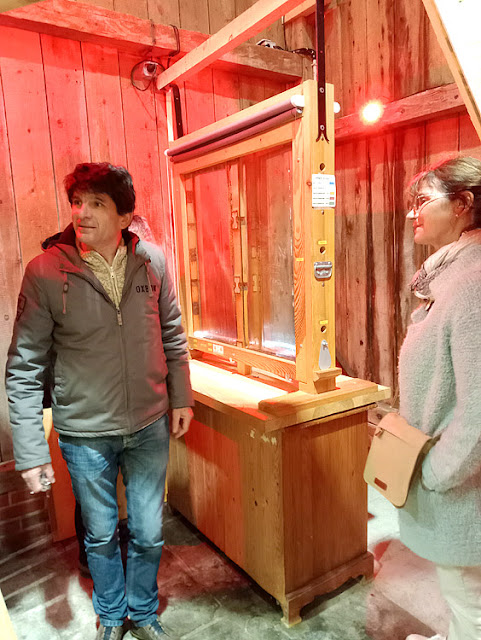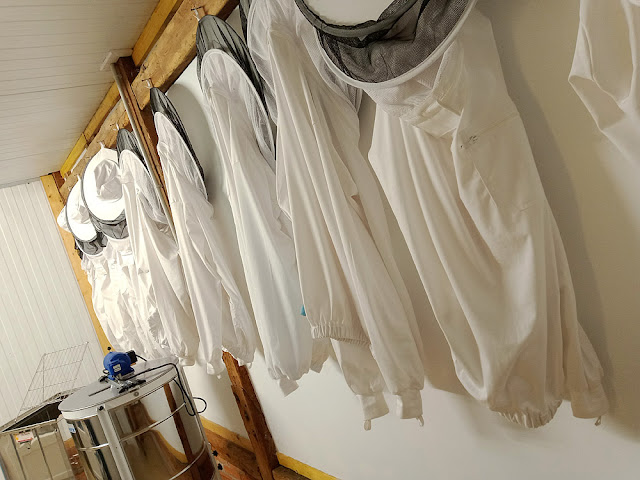Recently I was invited to a private group visit of the Maison des Abeilles at Champigny sur Veude. It is a community project led by beekeeper Alain Pageard.
View of the greenway, with crossing keeper cottage on left, the Sainte Chapelle centre and the plan d'eau beyond the vegetable garden on the right.
The former railway line between Richelieu and Chinon has been turned into a greenway (Fr. voie verte). At Champigny the old station building has been renovated and is now a small exhibition space to inform the public about the local area. The agriculture of the Pays Richelois was featured -- melons, asparagus, saffron, truffles and goat cheese.
Eric (naturalist), Christian (president Botamyco37), Jean-Paul (maker and nature lover), Eric (nature lover), Jacqueline (artist), Alain (beekeeper), Francoise (beekeeper) and Cyril (naturalist).
The goods shed has been taken over by the Maison des Abeilles, and Alain explained how the intention is to have a site which is integrated with the adjoining public spaces or attractions such as the plan d'eau (village pond) and La Sainte Chapelle de Champigny sur Veude. The land around the station is slowly being turned into a pollinator garden, with picnic area. Further down the track is the old crossing keeper's cottage, which may get turned into holiday accommodation. There are plans for a footbridge over the Veude to give better access to the plan d'eau from the Maison des Abeilles. And I was there to provide advice about an insect hotel.
A bed sown with crops that are nectar rich, including flax (Fr. lin), phacelia, canola (Fr. colza), and field beans (Fr. ). Alain commented on how slug munched the canola was and how it showed why farmers treat canola with so many pesticides, which is problematic for beekeepers. Personally, I never buy canola honey.
Inside the Maison des abeilles (House of Bees). The idea is that it represents the inside of a hive. The wax comb is made of paving reinforcing grids for gravel paths. Genius I thought, and Alain was quite pleased with himself for having discovered it in yellow at the hardware store.
Old style bee hives. From left, made from cattle manure; wicker; chestnut staves with wicker and mud daub fill; woven rush (I think, but it might be hemp).
Feral bee hives. On the left, in a tree trunk. The forester who cut this tree was very surprised to discover an active bee hive. On the right, two-thirds of a hive that had been living in a chimney for a decade. The wax at the top is black, old and no longer in use. The bees abandon sections of the hive successively as it gets dirty and unhygenic.
Visible bee hive. This glass cabinet is connected to a regular hive outside by a tube and the bees will enter the cabinet and treat it like part of the hive. They'll fill it with wax comb and start storing honey and raising a brood there. Visitors can see the activity, and are invited to put their ear to the special holes to hear the activity.
Beekeepers suits. Alain runs beekeeping workshops here which I'm told are excellent.









2 comments:
I'm very happy to have bees in my garden, and have lots of flowering herbs which they love. I would like to encourage the wasps to leave, though.
Katie: But the wasps are doing a great job of cleaning up dead bodies and getting rid of pests.
Post a Comment